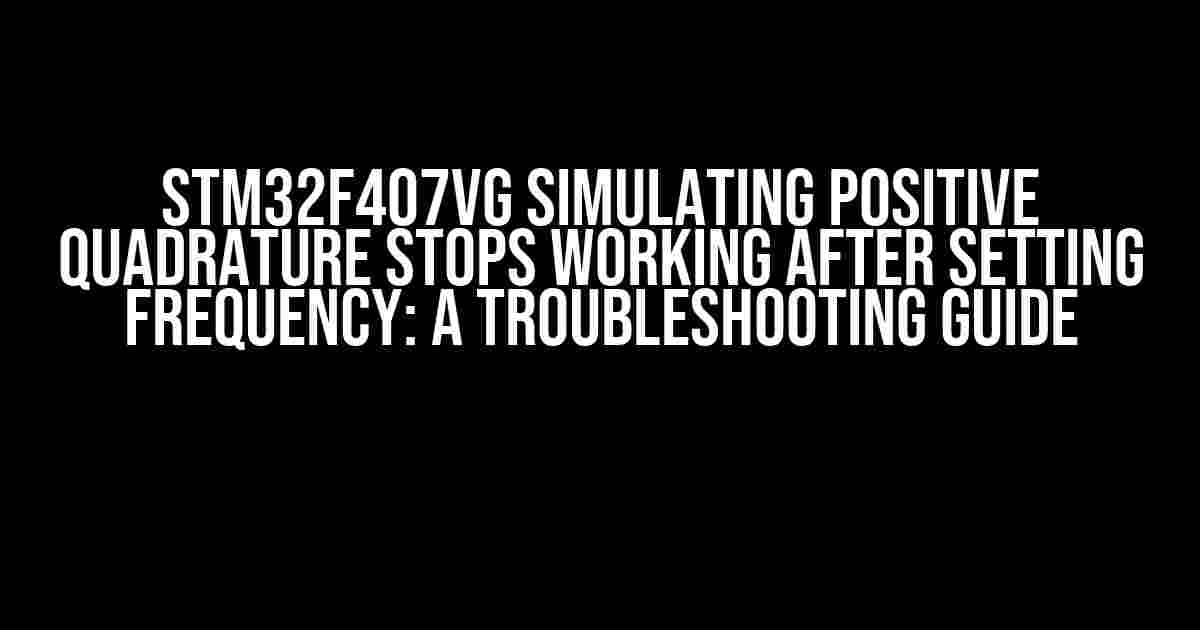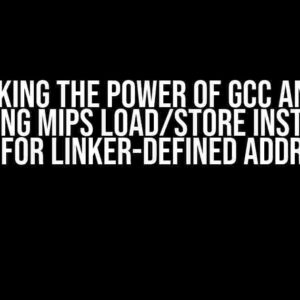If you’re an embedded systems enthusiast or a professional working with the STM32F407VG microcontroller, you might have stumbled upon an infuriating issue: simulating positive quadrature stops working after setting the frequency. Don’t worry, you’re not alone! In this article, we’ll delve into the possible causes and provide step-by-step solutions to get your quadrature encoder simulation up and running smoothly.
Understanding Quadrature Encoders and the STM32F407VG
Before we dive into the troubleshooting process, let’s briefly review the basics. A quadrature encoder is an optical or mechanical sensor that tracks rotary movement and provides two output signals (A and B) that are 90 electrical degrees out of phase. This allows the microcontroller to determine the direction of rotation and the number of revolutions.
The STM32F407VG is a popular 32-bit microcontroller from STMicroelectronics, widely used in various applications, including robotics, motor control, and industrial automation. It features a range of peripherals, including timers, UARTs, and interface modules, making it an ideal choice for quadrature encoder-based projects.
Symptoms of the Issue
So, what exactly happens when simulating positive quadrature stops working after setting the frequency? You might observe the following symptoms:
- The quadrature encoder simulation works correctly before setting the frequency.
- After setting the frequency, the simulation stops responding or producing incorrect results.
- The issue persists even after re-initializing the quadrature encoder peripheral or adjusting the timer settings.
Possible Causes of the Issue
There are several reasons why simulating positive quadrature might stop working after setting the frequency. Let’s explore the most common causes:
- Incorrect Timer Configuration: Misconfigured timer settings can disrupt the quadrature encoder simulation. Make sure you’ve set the correct timer mode, clock frequency, and counter values.
- Inadequate Clock Speed: If the clock speed is too low, it might not be able to keep up with the quadrature encoder signal, leading to simulation errors.
- Insufficient Input Capture Resolution: The input capture resolution determines the accuracy of the quadrature encoder signal measurement. If the resolution is too low, it can cause the simulation to malfunction.
- Noise or Interference: Electrical noise or interference can corrupt the quadrature encoder signal, leading to simulation errors.
- Software Issues: Bugs or incorrect implementation of the quadrature encoder simulation algorithm can cause the issue.
Step-by-Step Troubleshooting Guide
Now that we’ve identified the possible causes, let’s follow a step-by-step approach to resolve the issue:
Step 1: Verify Timer Configuration
Check your timer configuration using the STM32CubeMX software or by reviewing your code. Ensure that:
- The timer mode is set to “Encoder Mode” or “Input Capture Mode.”
- The clock frequency is set correctly (e.g., 42 MHz for the STM32F407VG).
- The counter values are correctly configured for the quadrature encoder signal frequency.
// Example timer configuration using STM32CubeMX
TIM_HandleTypeDef htim1;
htim1.Instance = TIM1;
htim1.Init.Prescaler = 42-1; // 42 MHz clock frequency
htim1.Init.CounterMode = TIM_COUNTERMODE_ENCODER;
htim1.Init.Period = 0xFFFF; // Maximum counter value
HAL_TIM_Base_Init(&htim1);
Step 2: Adjust Clock Speed
If you suspect that the clock speed is too low, try increasing it. However, be mindful of the microcontroller’s clock speed limitations and potential effects on power consumption.
For example, to increase the clock speed to 84 MHz using the STM32CubeMX software:
// Example clock configuration using STM32CubeMX
RCC_OscInitStruct.OscillatorType = RCC_OSCILLATORTYPE_HSE;
RCC_OscInitStruct.HSEState = RCC_HSE_ON;
RCC_OscInitStruct.PLLState = RCC_PLL_ON;
RCC_OscInitStruct.PLLSource = RCC_PLLSOURCE_HSE;
RCC_OscInitStruct.PLLM = 25;
RCC_OscInitStruct.PLLN = 336;
RCC_OscInitStruct.PLLP = RCC_PLLP_DIV2;
RCC_OscInitStruct.PLLQ = 4;
HAL_RCC_PLL_Config(&RCC_OscInitStruct);
Step 3: Optimize Input Capture Resolution
Increase the input capture resolution to improve the accuracy of the quadrature encoder signal measurement. You can do this by:
- Increasing the timer clock frequency.
- Reducing the counter values.
- Using a higher-resolution timer (e.g., 16-bit or 32-bit timers).
// Example input capture configuration using STM32CubeMX
TIM_IC_InitTypeDef sConfigIC;
sConfigIC.IC_Filter = 0;
sConfigIC.IC_Polarity = TIM_ICPOLARITY_BOTHEDGE;
sConfigIC.IC_Selection = TIM_ICSELECTION_DIRECTTI;
sConfigIC.IC_Prescaler = TIM_ICPSC_DIV1;
sConfigIC.IC_Mode = TIM_ICMODE_INPUT;
HAL_TIM_IC_ConfigChannel(&htim1, &sConfigIC, TIM_CHANNEL_1);
Step 4: Minimize Noise and Interference
To reduce noise and interference, consider the following measures:
- Use a high-quality quadrature encoder with built-in noise filtering or signal conditioning.
- Implement a software-based noise filter or signal conditioning algorithm.
- Use a shielded cable or a twisted pair cable to connect the quadrature encoder to the microcontroller.
- Keep the quadrature encoder signal lines away from noisy power lines or other sources of electromagnetic interference.
Step 5: Review and Optimize Software Implementation
Review your software implementation to ensure that:
- The quadrature encoder simulation algorithm is correctly implemented.
- The timer interrupts are properly handled.
- The input capture values are correctly calculated and processed.
// Example quadrature encoder simulation algorithm
void HAL_TIM_IC_CaptureCallback(TIM_HandleTypeDef *htim)
{
// Get the input capture values
uint16_t capture_value = HAL_TIM_ReadCapturedValue(htim, TIM_CHANNEL_1);
// Calculate the quadrature encoder position and direction
// ...
}
Conclusion
In this article, we’ve explored the possible causes and step-by-step solutions to resolve the issue of simulating positive quadrature stops working after setting the frequency on the STM32F407VG microcontroller. By following these guidelines, you should be able to identify and fix the root cause of the problem, ensuring that your quadrature encoder simulation works accurately and reliably.
| Troubleshooting Step | Possible Cause | Solution |
|---|---|---|
| Step 1: Verify Timer Configuration | Incorrect Timer Configuration | Check and adjust timer settings using STM32CubeMX or code review |
| Step 2: Adjust Clock Speed | Inadequate Clock Speed | Increase clock speed or optimize timer configuration |
| Step 3: Optimize Input Capture Resolution | Insufficient Input Capture Resolution | Increase timer clock frequency, reduce counter values, or use higher-resolution timers |
| Step 4: Minimize Noise and Interference | Noise or Interference | Use high-quality quadrature encoders, implement software noise filters, or optimize signal lines |
| Step 5: Review and Optimize Software Implementation | Software Issues | Review and optimize quadrature encoder simulation algorithm and timer interrupt handling |
By following these steps and understanding the underlying causes, you’ll be well on your way to resolving the issue and achieving accurate quadrature encoder simulation on your STM32F407VG-based project.
Additional Resources
For further information on the STM32F407VG microcontroller and quadrature encoder simulation, refer to the following resources:
- STM32F407VG Datasheet:
Share this:



